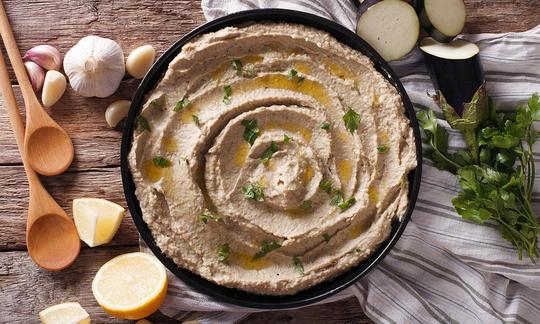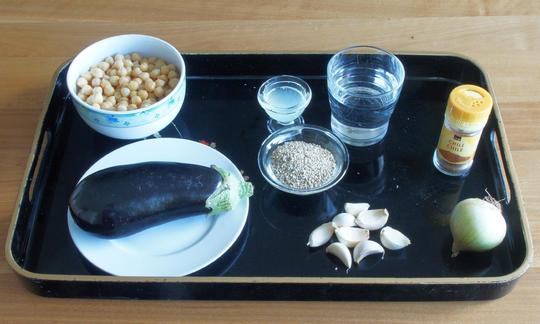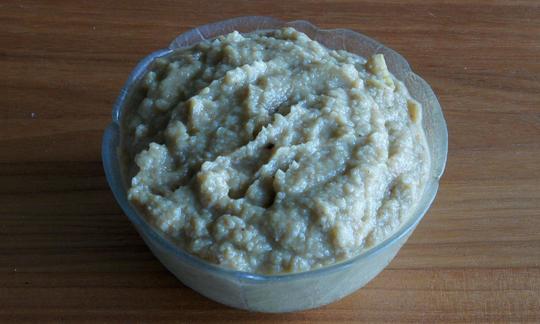Eggplant Hummus with Sesame Seeds, Onions, and Garlic
vegan
Ingredients (for servings, )
| For the chickpea and eggplant base | |
|---|---|
| 7 ½ oz | Chickpeas, raw (organic?) |
| 1 | Eggplant, raw (organic?) (12 oz) |
| For the rest of the hummus | |
| 1 | Onions, raw (organic?) (3.9 oz) |
| 8 cloves | Garlic (organic?) (0.84 oz) |
| 4 tbsp | Sesame, raw, unpeeled (sesame seeds, organic?) (1.3 oz) |
| 2 tbsp | Lemon juice (raw?, organic?) (0.51 oz) |
| ½ tsp | Chili powder (raw?, organic?) (0.05 oz) |
| 80 ml | Drinking water, raw (organic?) (2.8 oz) |
Equipment
- hand-held blender / immersion blender or blender
- garlic press
- saucepan
- oven
Type of preparation
- cook
- bake
- chop or grind
- soak
- purée
- remove the skin
Preparation
For the chickpea and eggplant base
Soak the chickpeas in plenty of fresh water for at least 12 hours or overnight — for 24 hours is even better.Chickpeas absorb a lot of water and tend to really “grow” in size — remember to take this into account when choosing the container and amount of water.
Place the chickpeas in a sieve and rinse briefly. Transfer to a large saucepan, cover with water, and cook.
The cooking time depends on how the chickpeas have been stored and for how long. For hummus, it is best to cook the chickpeas somewhat longer so that they are more soft. If the chickpeas are still al dente (slightly firm to the bite) after 1–1.5 hours of cooking time, then let them cook for a total of 2–2.5 hours. Check occasionally to make sure there is still enough water in the saucepan.
Please note: Do not add salt under any circumstances as this will considerably prolong the required cooking time!
When the chickpeas are ready, drain them in a sieve and let cool.
If you are using canned chickpeas, you can start directly with Step 4.
Bake the eggplant in the oven at 180 ° C for 45 minutes.
For the rest of the hummus
Dice the onion and add to the eggplant in the oven along with the whole garlic cloves for the last 15 minutes of the baking time.Remove from the oven, let the eggplant cool, and then remove the skin.
After the eggplant is cool, it is usually easy to remove the skin by hand. However, if you have any difficulties, you can also scoop out the eggplant flesh with a spoon.
After the garlic cloves have cooled, remove the skin, crush the cloves with a knife, and put through a garlic press.
Transfer the eggplant and crushed garlic to a measuring cup. Add the chickpeas, sesame seeds, lemon juice, baked onion, and the chili powder.
Purée with an immersion blender, adding water as necessary to achieve a smooth and creamy mixture. Serve immediately.
To give the hummus a finishing touch, garnish with fresh parsley and sprinkle some paprika on top.
|
Nutritional Information per person
Convert per 100g
|
2000 kcal | |
|---|---|---|
| Energy | 302 kcal | 15.1% |
| Fat/Lipids | 8.1 g | 11.5% |
| Saturated Fats | 1.0 g | 5.1% |
| Carbohydrates (inc.dietary fiber) | 47 g | 17.3% |
| Sugars | 10 g | 11.4% |
| Fiber | 11 g | 44.2% |
| Protein/Albumin | 14 g | 28.9% |
| Cooking Salt (Na:28.5 mg) | 72 mg | 3.0% |
| Essential micronutrients with the highest proportions | per person | 2000 kcal | |
|---|---|---|---|
| Vit | Folate, as the active form of folic acid (née vitamin B9 and | 340 µg | 170.0% |
| Min | Copper, Cu | 0.83 mg | 83.0% |
| Min | Manganese, Mn | 1.7 mg | 83.0% |
| Prot | Tryptophan (Trp, W) | 0.16 g | 65.0% |
| Prot | Threonine (Thr, T) | 0.54 g | 58.0% |
| Prot | Isoleucine (Ile, I) | 0.61 g | 49.0% |
| Prot | Phenylalanine (Phe, F) | 0.75 g | 48.0% |
| Prot | Lysine (Lys, K) | 0.88 g | 47.0% |
| Prot | Leucine (Leu, L) | 1.0 g | 42.0% |
| Vit | Vitamin B6 (pyridoxine) | 0.55 mg | 40.0% |
Detailed Nutritional Information per Person for this Recipe
The majority of the nutritional information comes from the USDA (US Department of Agriculture). This means that the information for natural products is often incomplete or only given within broader categories, whereas in most cases products made from these have more complete information displayed.
If we take flaxseed, for example, the important essential amino acid ALA (omega-3) is only included in an overarching category whereas for flaxseed oil ALA is listed specifically. In time, we will be able to change this, but it will require a lot of work. An “i” appears behind ingredients that have been adjusted and an explanation appears when you hover over this symbol.
For Erb Muesli, the original calculations resulted in 48 % of the daily requirement of ALA — but with the correction, we see that the muesli actually covers >100 % of the necessary recommendation for the omega-3 fatty acid ALA. Our goal is to eventually be able to compare the nutritional value of our recipes with those that are used in conventional western lifestyles.
| Essential fatty acids | per person | 2000 kcal |
|---|---|---|
| Linoleic acid; LA; 18:2 omega-6 | 3.5 g | 35.0% |
| Alpha-Linolenic acid; ALA; 18:3 omega-3 | 0.10 g | 5.0% |
| Essential amino acids | per person | 2000 kcal |
|---|---|---|
| Tryptophan (Trp, W) | 0.16 g | 65.0% |
| Threonine (Thr, T) | 0.54 g | 58.0% |
| Isoleucine (Ile, I) | 0.61 g | 49.0% |
| Phenylalanine (Phe, F) | 0.75 g | 48.0% |
| Lysine (Lys, K) | 0.88 g | 47.0% |
| Leucine (Leu, L) | 1.0 g | 42.0% |
| Valine (Val, V) | 0.64 g | 39.0% |
| Methionine (Met, M) | 0.22 g | 23.0% |
| Vitamins | per person | 2000 kcal |
|---|---|---|
| Folate, as the active form of folic acid (née vitamin B9 and | 340 µg | 170.0% |
| Vitamin B6 (pyridoxine) | 0.55 mg | 40.0% |
| Thiamine (vitamin B1) | 0.39 mg | 36.0% |
| Pantothenic acid (vitamin B5) | 1.2 mg | 20.0% |
| Riboflavin (vitamin B2) | 0.19 mg | 13.0% |
| Biotin (ex vitamin B7, H) | 6.6 µg | 13.0% |
| Vitamin C (ascorbic acid) | 9.4 mg | 12.0% |
| Niacin (née vitamin B3) | 1.9 mg | 12.0% |
| Vitamin K | 8.5 µg | 11.0% |
| Vitamin E, as a-TEs | 0.87 mg | 7.0% |
| Vitamin A, as RAE | 7.5 µg | 1.0% |
| Essential macroelements (macronutrients) | per person | 2000 kcal |
|---|---|---|
| Potassium, K | 706 mg | 35.0% |
| Phosphorus, P | 234 mg | 33.0% |
| Magnesium, Mg | 92 mg | 25.0% |
| Calcium, Ca | 146 mg | 18.0% |
| Sodium, Na | 29 mg | 4.0% |
| Essential trace elements (micronutrients) | per person | 2000 kcal |
|---|---|---|
| Copper, Cu | 0.83 mg | 83.0% |
| Manganese, Mn | 1.7 mg | 83.0% |
| Iron, Fe | 4.1 mg | 29.0% |
| Zinc, Zn | 2.5 mg | 25.0% |
| Selenium, Se | 4.4 µg | 8.0% |
| Iod, I (Jod, J) | 13 µg | 8.0% |
| Fluorine, F | 18 µg | 1.0% |
This eggplant hummus is a delicious variation on traditional Middle Eastern hummus and is delicious as a vegetable dip or spread.
Hummus in Middle Eastern cuisine: In Middle Eastern cuisine, hummus is usually one component of a meal (often a starter) that consists of many smaller dishes. It is ideal as a dip (e.g., for vegetable sticks) and is also often used as a filling, for example, for flat bread.
Information about chickpeas: With an average of 20 g protein per 100 g, chickpeas are very high in protein and therefore a good addition to vegetables. Chickpeas (like many other legumes) are usually available in stores either dried or precooked (canned). While the canned version is of course more convenient and time-efficient, dried chickpeas that you cook yourself have a much better taste. And when you cook them at home, you can decide how firm you want them to be (canned chickpeas are often very soft, sometimes even mushy). In addition, canned foods often contain unnecessary additives or are already salted. It is therefore best to use the unprocessed version whenever possible.
Ideal dipping vegetables: Carrots, cucumbers, kohlrabi, and cherry tomatoes are good choices to include when serving dip and vegetables.
Hummus as a topping: You can also use the eggplant hummus as a topping for (sweet) potatoes.
Quick variation: To skip the soaking time, you can buy precooked chickpeas in jars. If you do this, you can prepare the recipe in an hour.
Spiciness: You can season this eggplant hummus with a variety of spices according to taste. Cayenne, for example, is suitable for all those who like a more spicy flavor. Another way to add spice is to blend a chili pepper into the hummus.
Basic recipe for hummus: If you would like to try another version, we recommend trying this basic recipe for hummus.










